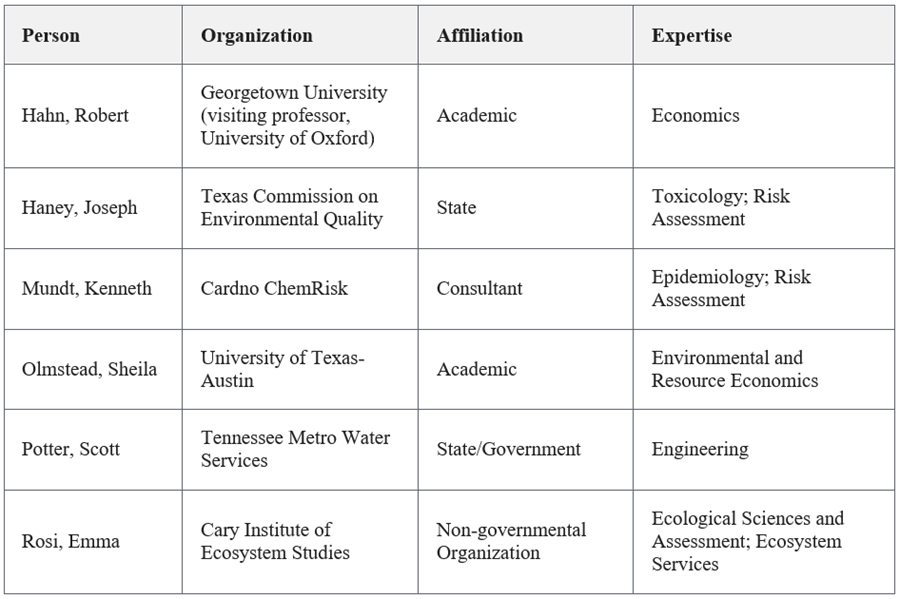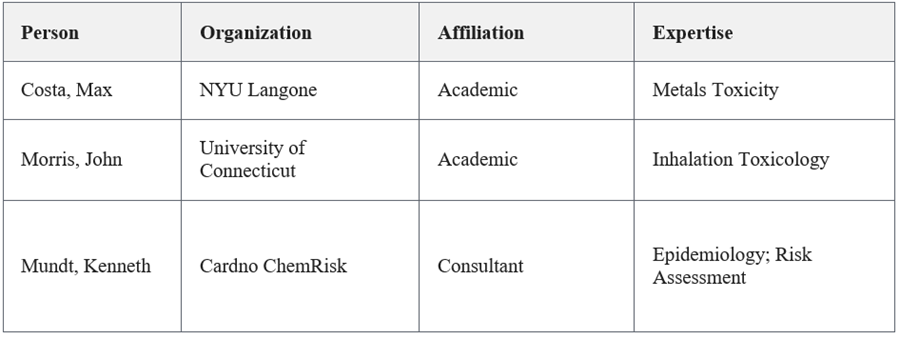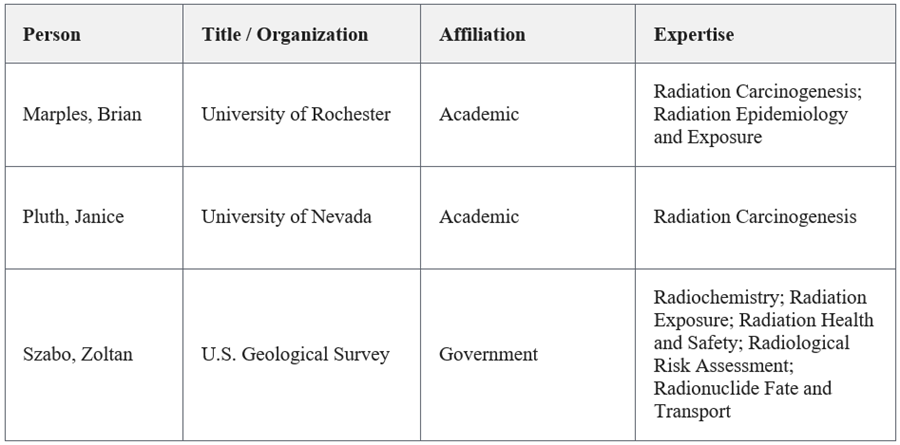Administrator Continues to Strive for Scientific and Geographical Diversity
“I’ve known John for years and he is really one of the best environmental scholars this country has to offer,†said EPA Administrator Andrew Wheeler. “His advice has been influential during his time on the SAB and I am looking to his future advice as Board Chair. I’m also pleased to announce Dr. Barbara Beck as the new Vice-Chair for the SAB. This Administration has re-established the importance of the SAB and utilized its very talented experts to provide advice on those issues critical to the Agency and its mission. I’m confident in their ability to help lead the Board as it continues to take on more projects and work more efficiently than ever before.â€
Dr. Graham has served as a member of the SAB for the past three years. He is a professor in the School of Public and Environmental Affairs (SPEA) at Indiana University (Bloomington and Indianapolis) and served as Dean from 2008 – 2019. His previous academic roles include Dean of the Pardee RAND Graduate School in California (2006-2008) and tenured Professor of Policy and Decision Sciences at the Harvard School of Public Health (1985-2001), where he founded and led the Harvard Center for Risk Analysis. At the request of President George W. Bush, Dr. Graham also served in the Executive Office of the President as Administrator of the U.S. Office of Management and Budget’s Office of Information and Regulatory Affairs (2001-2006). In this capacity, Dr. Graham led the regulatory-review, statistical, and information-policy functions of the federal government. Dr. Graham earned his BA in economics and politics from Wake Forest University (1978), his MA in public affairs from Duke University (1980), and his Ph.D. in public affairs from Carnegie-Mellon University (1983). After his PhD, Dr. Graham was an EPA-supported post-doctoral fellow in environmental health at the Harvard School of Public Health.
“Dr. Graham is a leading scholar of risk analysis and the use of scientific information in EPA decision making. He is an experienced and effective leader of academic and government institutions. Under his chairmanship, the SAB will provide a clear voice for soundly reasoned decision making,†said Harvard School of Public Health Professor James Hammitt.
“As an environmental chemist, I was happy to have been led for more than a decade by Professor Graham. He was an effective and visionary leader who respected the crucial roles that the physical and natural sciences play in developing environmental policy. He was always supportive of the sciences in the O’Neill School. I was on the search committee that selected him, and I am pleased to say that we made the right choice,†said Indiana University Distinguished Professor Emeritus Ron Hites.
To work with Dr. Graham as the Vice-Chair of the SAB, Administrator Wheeler has selected Dr. Barbara Beck. Dr. Beck has also served as a member of the SAB for the past two years. Dr. Beck is a principal at Gradient, an environmental and risk sciences consulting firm. She is an expert in toxicology and human health risk assessment for environmental chemicals, especially metals and air pollutants. Her broad experience in risk assessment includes toxicological evaluations of many different types of chemicals, along with the development of evaluation methodologies. Several of her publications have received awards from organizations such as the Society of Toxicology’s Risk Assessment Specialty Section and EPA. Dr. Beck’s participation in advisory committees and expert panels, such as the National Research Council, the International Life Sciences Institute, and her local Board of Health, has spanned over thirty years. She received her Ph.D. in molecular biology and microbiology from Tufts University and her B.A. in biology from Bryn Mawr College (cum laude).
“With today’s announcements, I’d also like to thank Dr. Honeycutt for his service these past three years,†said EPA Administrator Andrew Wheeler. “Dr. Honeycutt’s leadership has been instrumental in addressing the many complex science issues facing the EPA and in helping this Administration reestablish the importance of the SAB.â€
Dr. Honeycutt has devoted many hours to the work of the SAB during his tenure. His steadfast leadership has enabled EPA to obtain independent advice on numerous scientific issues, including a review of EPA’s Identification of Research Needs to Address the Environmental and Human Health Impacts of COVID-19 and EPA’s draft technical report entitled Screening Methodologies to Support Risk and Technology Reviews (RTR): A Case Study Analysis. He also oversaw the SAB’s scientific advice regarding proposed actions on the Agency’s regulatory agenda, including the draft Strengthening Transparency in Regulatory Science Rulemaking.
SAB has provided numerous consultations under Dr. Honeycutt’s leadership, including consultation on New Approach Methods and Reducing the Use of Laboratory Animals for Chronic and Carcinogenicity Testing, a consultation on Mechanisms for Secure Access to Personally-Identifying Information and Confidential Business Information Under the Proposed Rule, Strengthening Transparency in Regulatory Science, and consultation on EPA’s Consolidated Human Toxicity Assessment Guideline. These are only a few of the many reviews his leadership has made possible, reviews that have assisted the EPA in making important progress in its mission to protect public health and safeguard our nation’s air, land, and water. Administrator Wheeler wishes Dr. Honeycutt continued success in his work at the Texas Council on Environmental Quality.
With this announcement, the Administrator is also appointing 16 new members to the Science Advisory Board and its four subcommittees, as detailed below.
“In a fair, open, and transparent fashion, EPA reviewed a diverse group of qualified applicants nominated for these committees,â€Â said EPA Administrator Andrew Wheeler. “Members who will be appointed or reappointed include experts from a wide variety of scientific disciplines who reflect the geographic diversity needed to represent all ten EPA regions.â€
Having expert scientists on the SAB who bring wide-ranging scientific perspectives and come from across the country has been a point of emphasis for this Administration. In FY 2021, 30 states and the District of Columbia will be represented on the SAB and its standing committees.
The Process
The EPA announced in a Federal Register Notice on April 1, 2020, that it was inviting nominations of experts to be considered for the Administrator’s appointment to the SAB and its four standing subcommittees. The nomination period was extended in another Federal Register Notice published on August 14, 2020. The nomination period closed on August 31, 2020. The SAB Staff Office identified 72 candidates that confirmed interest to serve on the Board and an additional 63 candidates with confirmed interest to serve on the four SAB subcommittees. Each of the candidates submitted bio-sketches and their curricula vitae. The List of Candidates was posted on the SAB website for a 21-day public comment period that closed on October 5, 2020.
The Science Advisory Board
In FY 2020 the SAB had 44 members. SAB members are initially appointed to serve a three-year term and may be reappointed for a second term. Twenty-three current SAB members’ terms (neither first nor second) do not expire this year and they will continue to serve on the Board. One member completed his second term and is ineligible for reappointment. Another member resigned earlier this year. Nineteen current members of the SAB have completed one term of service. Thirteen of these first-term members will be reappointed by Administrator Wheeler. In addition, Administrator Wheeler is also appointing six new board members (listed in table 1 below) to bring the total SAB membership to 42 for FY 2021. Dr. John Graham will be appointed as the new SAB Chair and Dr. Barbara Beck will be appointed as the SAB Vice-Chair.
The Agricultural Science Committee
In FY 2020, the ASC had 21 members. No members had expiring terms and thus all remain on the committee. The Administrator is appointing one new committee member (listed in table 2 below). Dr. Otto Doering continues as the ASC Chairman.
The Chemical Assessment Advisory Committee
In FY 2020, the CAAC had 19 members. Of those, 17 members had terms that do not expire and thus remain on the committee. Two CAAC members completed their second term of service in FY 2020. No members had their first three-year term expire. Administrator Wheeler is appointing three new committee members (listed in table 3 below), Dr. Kenneth Mundt will be appointed the new CAAC Chairman.
The Drinking Water Committee
In FY 2020, the DWC had 13 members. Of those, ten members had terms that do not expire and thus remain on the committee. Three DWC members completed their second terms in FY 2020. In addition, the Administrator is appointing three new committee members (listed in table 4 below). Scott Potter will be appointed the new DWC Chairman.
The Radiation Advisory Committee
In FY 2020, the RAC had 14 members. Of those, 9 members had terms which do not expire and thus will remain on the committee. Five RAC members completed their second term of service in FY 2020. The Administrator is nominating three new committee members (listed in table 5 below.) Dr. Brant Ulsh continues as the RAC Chairman.
“I sincerely thank each of the scientists leaving the SAB for their service to the Agency and I welcome the new appointees and look forward to your counsel and advice as the Agency continues to tackle some significant scientific challenges facing our country,â€Â said EPA Administrator Andrew Wheeler.
The SAB was established in 1978 by the Environmental Research, Development, and Demonstration Authorization Act to provide independent advice to the EPA Administrator on a range of scientific and technical matters underlying its policy and regulatory decisions. The SAB is a scientific advisory committee whose members are experts in the fields of science, engineering, and economics and are appointed by the EPA Administrator. The SAB operates under the requirements of the Federal Advisory Committee Act.
A complete roster for the SAB and each standing subcommittee can be found at:Â https://yosemite.epa.gov/sab/sabproduct.nsf/WebBOARD/CommitteesandMembership?OpenDocument
New SAB Members

New ASC Member

New CAAC Members

New DWC Members

New RAC Members







